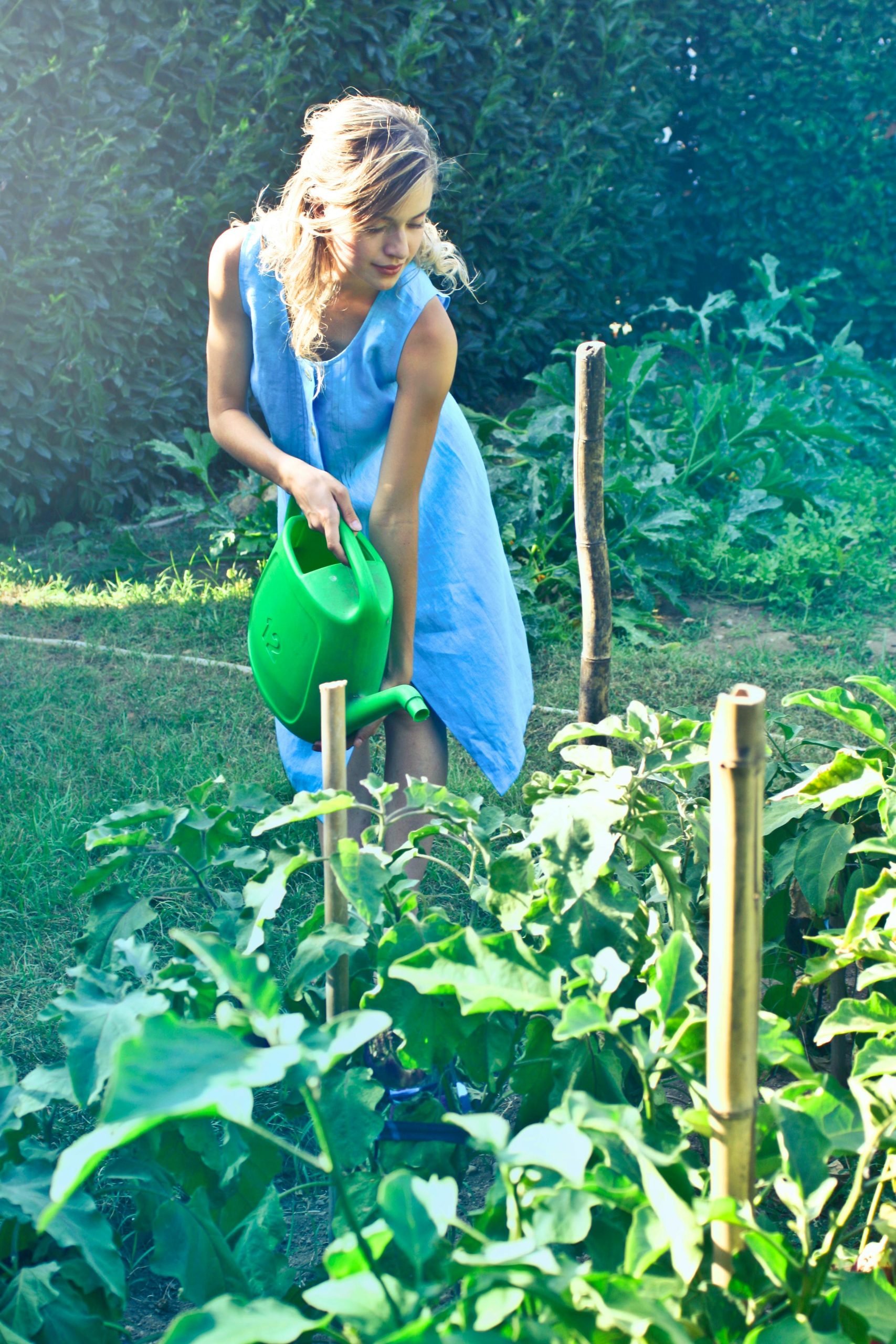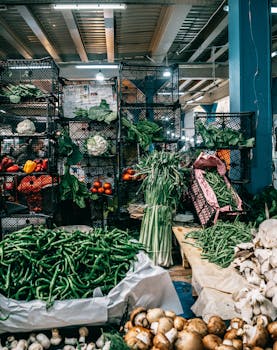If you don’t have any yard space or you live in a climate with a short season, you can still exercise your green thumb indoors with these ideas…a few will even produce fresh produce too! You’ll find tips for assorted herbs, a couple vegetables and a few neat-o plants to try your hand at. They will do well inside year round but many will thrive outdoors during the summer months (if you have the space) but move them indoors once it gets a little chilly and before the first frost (imagine having home grown fresh tomatoes over the winter!).
Never Pay For Onions Again
Onion Recycling Tutorial :
I learned this tip a couple of years ago and have tried it and found that it works and is quite marvelous. I love to use fresh green onions but am always out or there is a slimy little bag of them in the bottom of the fridge.
Here is my marvelous tip for growing them yourself and recycling a bit.
The trick is to take the cut end (root side) and plant it in a pot, water well, give it some time and voila! You have fresh (and free!) onions at your disposal. This will work for a variety of different onions and the beauty of this tip is that as you use the onions, you replant the cut root ends to grow more. You can use a tub just for onions and haul it indoors during winter months (will need lots of sun) or if it’s just green onions you’re interested in growing, a large flower pot will do.
Please visit the site for complete details, great tip! (This was previously featured in 2008 on Tipnut and moved to this page for better organization).
Yes Tomatoes Can Thrive Indoors
We get spoiled with juicy, tasty tomatoes during gardening season, but then it gets tough to settle for store bought over the winter months. Why not try growing some indoors! Mother Earth News has a good article that’s full of tips to get you started:
Although many varieties of compact bush tomatoes are advertised as good for container production, they won’t perform well over a long winter. These are determinate varieties – plants with branches that grow to a certain length and then stop. They produce a finite number of fruits over a limited period, certainly far less time than a long stretch of northern winter.
Better options for indoor winter tomatoes are indeterminate varieties, those that continue growing and producing indefinitely. Furthermore, I’ve found that cherry and plum types, bearing small fruits in abundance, are more productive than large slicing types.
You’ll find all the details here: Growing Tomatoes Indoors All Through The Winter .
Bean Sprouts In A Jar
Here’s a great idea for cutting grocery costs, grow your own bean sprouts just using a jar and lid–no garden space required, you can grow these in your kitchen! Here’s a video tutorial I found that shows how easy it is:
Notes:
*Watch the video for full details
- You can grow sprouts in your kitchen using lentils, a large jar and a lid with a screen that you can buy at a health food store. I’m sure you could also use a scrap of cheesecloth over the mouth of the jar and a ring screwed on over top (or use a thick rubber band to secure the cloth).
- Pour some of the beans into the jar (about 1/2 cup), put the lid on top then cover the lentils with water (use at least 4 times the amount of water than lentils).
- Leave overnight to soak.
- The next day, pour the water off and leave the jar upside down to drain all the water out.
- Rinse the beans in the jar daily, drain very well, lay the jar on its side with the beans evenly distributed along the jar.
- In about 4 days you’ll be able to eat them (wait until the sprout is about as long as the bean).
I didn’t realize how easy it was to grow these, and the tools and space needed are so basic that anyone can afford to grow as many sprouts as they want! (originally published here on Tipnut January 27, 2009, and moved here for better organization).
Plant From An Avocado Pit
Did you know that if you save the pit from an avocado, you can grow an indoor tree from it? You’ll need a pit from a very ripe avocado, wash it well to remove any traces of fruit and then allow it to dry for a few days.
After drying, the pit is suspended in a glass of water and once there is root growth of about 2″, it can be planted in a pot of soil and tended to as a houseplant. If your climate allows, you can plant this outdoors.
If you’re looking for fruit, you’ll likely be disappointed since chances are it won’t bear any but if you’re looking for something different to try, this fits the bill. It’s also a good project to get the kids interested in plant life. This is one of the first tips published on Tipnut (in 2006) and I think it’s a fun one!
See full details on this page: Tips For Growing An Avocado Tree .
Charming Kitchen Plants From The Garden
Flowers and house plants are not the only types of greenery which will enhance the appearance of the home. Vegetable arrangements are attractive and original. A vegetable plant placed on a sunny window ledge will last for months. The best way to grow vegetable plants is in water.
Appropriate for the kitchen are the old-fashioned sweet potato plant and carrot greens. Place a large sweet potato, which has already sprouted, in a glass vase so that the entire potato is covered with water except for a small area at the top. If the plant is kept in the sunlight for a short time, foliage will appear. Vines can be trained in any direction and, as the plant grows, it will become a decoration worthy of display in any room in the house.
Carrots, treated in the same fashion, will develop a charming lacy green foliage, and watermelon vines–the products of watermelon seeds planted in rich soil–are an attractive addition to kitchen greenery. The seeds of lemons, oranges and grapefruit also produce tiny tree-like plants.
To grow a beet plant, fill a large shallow pottery bowl with clean sand and some small rocks. Cut off half an inch or so from the bottoms of several good-size beets (so that they will sit firmly) and place them in the bowl. Remove the largest, oldest leaves. Keep the water level so that about one inch of each bulb is uncovered and set the bowl in a cool, shady place for a few days. Add water when needed.
Other vegetables which can be converted into lovely house plants are onions, carrots, kale, common garden leeks, turnips and celery.
DIY Pineapple Plant
Here’s a quick tip from Old-Time Tips For Flowers & Plants: Timeless Wisdom : The top of a pineapple, planted in a pint jar of water, will sprout and root, soon making an exotic and most attractive palm-like plant.
It won’t bear any fruit but it’s another interesting plant to try. I found more detailed tips from You Grow Girl here: Save Your Plant – Pineapple Top
It seems nearly mythological that anyone can grow a tropical fruit such as pineapple in his or her own home. But as long as you have a sunny window and a moderate indoor climate you can grow your own.
Don’t expect a large harvest. Each plant produces one fruit and yours will never grow to the size of a full grown Hawaiian-farmed plant, unless you do live in a tropical climate.
Herbs On Your Kitchen Counter
If you’d like a garden pot full of your favorite herbs to enjoy year round but aren’t sure how to get started or which herbs are a good bet to try, here’s an article from CHOW that has lots of tips to get you started: How to Grow Herbs Indoors
WHICH HERBS TO GROW
Here’s a breakdown of what to grow, for clueless gardeners to the greenest of thumbs. Or jump to an explanation of light, water, pots, soil, food, and more.
The article shares tips for growing favorites such as rosemary, thyme, oregano and basil (there are just over a dozen different herbs listed) along with advice for soil, lighting, feeding and more. Good reference!
Garlic Greens
You can use an empty coffee/tin can, a flower pot or other container. A head of garlic is split (leaving as much of the papery skin on as possible), then each clove is planted in soil.
Article source: http://tipnut.com/nifty-food-plants/



